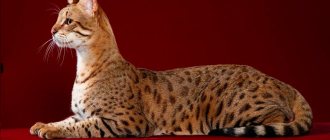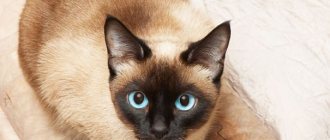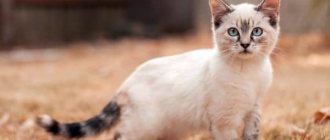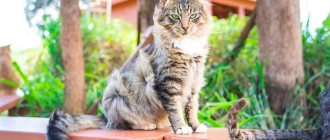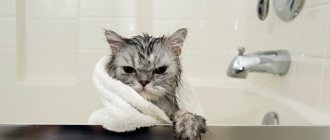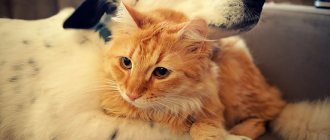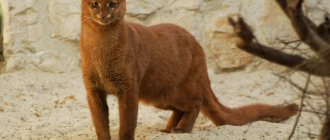Feeding pets is a real pleasure. By buying expensive food and various treats, owners strive to express their love and care for cats. Animals, in turn, gratefully eat everything that is provided to them, and this inevitably affects their weight.
Animals that resemble a swollen ball in shape do not always remain dexterous and flexible, but their clumsiness looks very funny and amusing. This forces people to once again look at photos and videos of such cats, which makes such pictures one of the most popular.
SpongeBob
In 2012, the Guinness Book of Records entered a new record - the fattest cat in the world was determined. It turned out to be a red-haired pet with an interesting nickname SpongeBob. Its weight is 15.5 kg, which is approximately equal to the weight of a four-year-old baby.
The cat ended up in a New York cattery, where he surprised the entire staff with his weight. The animal underwent a full examination to exclude the possibility of diseases. And it turned out that the cat was completely healthy.
True, the nursery staff are sure that excess weight is not the norm for a 9-year-old cat. And they try to help him get rid of the extra pounds through a special diet and special exercises. Veterinarians expect that losing excess weight will allow the cat to move normally.
Famous fat bellies
You can now see a lot of fat cats on the Internet, which often become the objects of jokes and memes. And this is almost always the fault of people who do not monitor how much the cat eats and how balanced its diet is. And the poor animal just gets fatter and fatter.
Elvis the cat
Elvis
Elvis, from Clydebank, Scotland, who had free access to food every day, ended up gaining 10kg, roughly doubling his normal weight. His owner, 55-year-old Carol Sweeney, never gave Elvis human food, but did not monitor his portion sizes. He could eat at any time of the day, and as soon as his plate was empty, the hostess immediately filled it. And very quickly Elvis gained weight. But the owner still realized that such dimensions were not normal for her pet, and after consultations with veterinarians, they switched the cat to a special diet and began to carefully weigh its portions.
Mr. Pickles
Mr. Pickles at the orphanage
A stray fat cat named Mr. Pickles is one of the biggest ones rescued by staff at a Scottish shelter. Three-year-old Mr Pickles was found in Balmedi. He was taken to the SSPCA (Scottish Society for the Prevention of Cruelty to Animals) Animal Rescue and Relocation Center in Drumoak. At that time his weight was 11.5 kg. A local charity immediately enrolled him in a weight loss and exercise program.
This giant is incredibly friendly. He loves having his belly rubbed and happily lies on his back with all four paws dangling in the air. Mr. Pickles was left in the care of veterinarians for quite some time, allowing him to gradually lose weight. This program included diet and exercise. He needed to lose weight to the ideal 5-6 kg.
Veterinarians were waiting for the cat to lose a little weight so that after that they could carry out the necessary examinations and find out whether obesity was harming his health. Only after Mr. Pickles reaches an appropriate weight will he be looked for a loving home who can continue with his diet and exercise plan.
Fat Thule
Tulle with Tabitha
This cute, fat guy from Denmark became one of the first internet phenomena to gain popularity in 2002 due to his enormous weight. Although many internet users assumed that Thule's photos were just photoshopped, he really was that fat and weighed about 19.2 kg. As a result of his obesity, Tulle developed kidney problems and diabetes, which forced him to euthanize the fattest cat on the planet at the time in early 2008. Due to excess weight, the cat could not walk independently and was constantly carried in arms. He even had his own blog, where they posted photos of him with 12-year-old Tabitha Pedersen.
Despite the fact that Tulle died due to complications caused by excess weight, looking at him, people began to post photos of obese cats online in large numbers; some of them may have been deliberately overfed by humans to out-compete Thule.
Cat Meow from Mexico
The Mexican cat Meow has surpassed its American relative. His weight reached 18 kg. Veterinarians at the New Mexico kennel also tried to help the animal lose weight. True, they failed. Unfortunately, the fat cat Meow died as a result of lung failure. Excess weight took its toll.
What are the dangers of obesity for a cat?
Videos and memes of fat cats sometimes become very popular, but in reality there is nothing very cute or funny about your beloved pets if they are obese. Although an adult cat's plump belly may not seem like much, these extra pounds can lead to very serious complications and cause serious harm to health in both the short and long term. There's no denying that the overweight cats you see on Instagram and YouTube are cute, they're just not healthy. The sad truth is that being overweight causes them a lot of suffering, and their owners need to provide them with the help they need, in addition to lots of “likes” on social media.
Overweight cat
The causes of obesity in cats are similar to those in other mammals such as dogs, horses and humans; This is usually an imbalance in caloric intake and activity level. In other words, most creatures gain weight when they eat more calories than they can burn. There are additional factors that contribute to this, such as neutered and spayed animals have a harder time losing weight because their metabolism slows down after the procedure. Animals that require medication may require more careful control of portions and activity levels, and isolated animals usually have a harder time losing weight. The same goes for animals that are stressed. Just like people, they can “eat” it. Additionally, the older a cat gets, the less active she is, and her metabolism also slows down.
The problem of feline obesity must be addressed quickly, as it is associated with a real health threat. Obese cats are at greater risk of developing various diseases such as diabetes, liver disease, arthritis, urinary problems, lameness, pancreatitis and gastrointestinal diseases of all types, as well as skin problems such as dandruff. Fat cats have a decreased quality of life and an increased risk of cancer.
The best way to treat obesity in pets is to prevent it in the first place. It may seem fun to feed your cat treats or food from your table all the time, but it is better to avoid consuming unnecessary and harmful foods, and also limit your cat's diet to special food, and set portion sizes in accordance with recommendations.
Well-fed Elvis
Another fat cat lives in Germany. His name is Elvis and he weighs 17.5 kg. Unlike some well-fed, but luckier relatives, the German fatty has health problems. He was diagnosed with diabetes, which developed due to obesity. The pet moves very little, because after a few steps it becomes difficult for him to bear such a large weight.
The cat's owners are currently trying their best to help him cope with excess weight. Elvis is given insulin injections twice a day and has also been prescribed a special diet to lose weight. They say that with the help of thoughtful nutrition, the gray and white cat got rid of 1 kilogram and continues to lose weight.
Now Elvis is considered “the fattest cat in Germany.” But according to the volunteers who took care of the animal’s health, this cat may receive the title of “the fattest cat in the world.” His weight, even after losing weight, remains greater than that of the cat, which is now recorded as “the fattest in the world” in the Guinness Book of Records.
Weight standards for cats and cats
According to international standards, the average adult cat has a total length of 71–73 cm, of which the tail is 28 cm, and weighs 2.8 kg (6.2 lb). An average adult cat with a total body length of 66 cm weighs 2.45 kg (5.4 lb). Its tail is about 24 cm. Neutered pets are heavier - from 3.2 to 5 kg. Their life processes are slowed down and their energy consumption is less . To determine the normal weight, measure the length of the cat's body from the tip of the nose to the beginning of the tail and divide the result by 16 . The resulting value is compared with what the scales show. If a pet is 800 g heavier, it is a sign of the onset of obesity. An animal’s body weight at one and a half years is an approximate guideline for its entire life. At this age, most breeds stop growing.
The normal weight of a cat depends on:
- on the quantity and composition of food;
- from physical activity;
- from the innate characteristics of the animal.
In large Maine Coons, the weight of castrated cats reaches 11.5–13.6 kg compared to animals for breeding. The standard for this breed is 4–5 kg for cats and 6–8.5 kg for males. Massive Ragdolls and Britons weigh up to 7–9 kg (males) and 5.5–6.7 kg (females). Neva Masquerade cats weigh 8 kg, and male cats are half that size, which corresponds to the norm. Male Siamese weigh no more than 5.5 kg, and male cats weigh up to three kilograms. A bobtail kitten normally weighs up to 3 kg at 4 months, and an adult cat weighs up to 7 kg. If the pet belongs to the miniature breed of cats (Singapore Drain Cat), then the weight of an adult animal does not exceed 2.8 kg when it is healthy.
Metabolic processes in adult cats may differ, as well as energy expenditure. Young animals play more, especially in the evenings in the presence of their owners. For them, spending 80 kilocalories of energy per kilogram of weight is the norm. From it the owner calculates the daily portion of food for the pet. To satiate a cat weighing 3.5 kg, 50 g of premium dry food and 150 ml of water per day are enough. It is more difficult if you feed homemade food. For a healthy animal weighing 3–5 kg, 200–250 g of chicken or beef per day is enough. Lazy representatives of the cat family spend 55–60 kcal per 1 kg of body weight and the portion of food for them is smaller.
A healthy pet with a normal weight has a noticeable waist. When pressed, a muscle-fat layer is felt on the ribs.
The abdominal fold helps to estimate the amount of fat. It is located closer to the hind legs. If the belly begins to sag, the neck becomes rounded and it becomes increasingly difficult to pick up the cat, it’s time to show him to the veterinarian.
Handsome Pikkis
The next representative of fat cats lives in Helsinki. He may well be the next contender for the title of fattest. His name is Bond, but his owners prefer to call him by his charming nickname Pikkis, which literally translates as Baby.
The cat weighs 16 kg and is 120 cm long, which is not at all surprising, since the animal belongs to the Maine Coon breed. This breed is considered the largest in the world, but even for its representatives, a weight of 16 kg is rare.
Spice
The beginning of the story of the furry glutton Spicy from Connecticut is unknown. He was first noticed by the media in 2008 and amazed people with his shape and fantastic laziness.
The size of the voracious tabby cat is amazing - he managed to gain 21 kg. It is unknown who helped this sloth reach such a size. The cat weighs six times more than a normal cat, like all fat cats, has difficulty moving and prefers sleeping in nature for physical activity.
Fat Thule from Denmark
The leader in terms of weight today can be called the cat Tulle. A fat cat weighing 19.5 kg is not able to care for itself. Of course, a pet does not catch mice; it is not at all interested in love affairs. But this is not surprising at such a weight.
The cat owes such a large body weight to its lifestyle. According to the owners, Tulle is very lazy. His favorite pastime is relaxing near the TV. In addition, the ginger cat loves to eat. So far there is no talk of any serious illnesses in the six-year-old cat, but his impressive weight is very worrying for his owners. They are going to send him to courses where they offer low-calorie diets and exercises to lose weight.
Fat pets rarely make it onto the pages of the Guinness Book of Records. It is possible to determine the fattest cat only by applications submitted by the owners. But not all cat owners think about having their pet’s name appear on the pages of the famous Book of Records. Therefore, it is likely that the fattest cat lives next door, but we don’t know anything about it.
Rating of the fattest cats in the world
Without knowing the limits of blind love for a pet, the owner rarely thinks about what free access to food leads to. Many fat animals are found in the US, where most cats live indoors. They have nowhere to run to expend energy, and owners do not consider it necessary to exercise with their pets.
In New Zealand, a third of domestic cats are overweight. A survey of 300 people conducted by Royal Canin found that 58% of cat owners do not measure the portions they feed their pets and only 23% give their pets daily exercise.
Interesting fact. In the 1970s in London, at Paddington metro station, a gray tabby cat named Tiddles, weighing 13.6 kg, lived in a ladies' toilet for 12 years. Fans bought him a personal refrigerator to store chicken liver, rabbit meat, lamb and steaks, which were brought to the cat for food.
SpongeBob is a grotesque copy of the red cat from the cartoon "Shrek the Third"
Information about a fat cat from New York was published by DailyMail in June 2012. This happened a week after the death of the animal. The elderly owner of a mustachioed glutton named Sponge Bob moved to live in a nursing home where keeping pets is prohibited. And his red tabby cat arrived at a New York animal shelter. When they opened the cage in which SpongeBob was, a dozen orphan workers stood silent for a long time, speechless. It was the biggest cat they had ever seen. The newcomer was placed in a large cage intended for a litter of puppies.
It's a difficult task to lose weight when there is a bowl of food nearby.
During the weigh-in, the cat tipped the scales by 33 pounds, or 14.97 kg. At 9 years old, food-hungry SpongeBob weighed the same as a two-year-old child. Staff at the Animal Haven shelter in New York put the fat cat on a strict diet and came up with daily exercises to encourage the cat to move. It helped me lose 3 pounds (1.36 kg) in just two months.
Kendra Mara, the shelter's assistant director, said SpongeBob had lost up to 30 pounds. The cat boldly jumps out of the enclosure, dragging its huge belly over the metal door opening. But the adorable fatty is still too big to wash his body and needs to be cleaned by hand. Kendra assumed that the cat's elderly owner was weakened by old age, so he fed the pet dry food, leaving it constantly available. The cat ate as much as he wanted and became a victim of his appetite.
Sponge was allowed to wander around the cat section of the shelter, greeting other cats sitting in cages. He played with laser lights and loved to ride on his back.
The shelter staff kept the cat moving by placing small pieces of treats on the floor. They managed to get them to run around the room. The hope was that the cat would lose 1-2 pounds per month and lose half his weight, losing over 15 pounds in 8 months. The strict diet consisted of low-fat chicken and canned fish. Low carbohydrate vegetables (boiled pumpkin) were added.
The shelter wanted him to be taken home by a new owner who would dedicate his time to playing with him and continue his healthy diet. And so one married couple from New York took a cat from a shelter. Less than two months had passed before Sponge's health deteriorated sharply. He died at the end of May 2012. Obesity was not the cause of death, but veterinarians did not dare treat it.
Two-year-old cat Meow from the American Santa Fe
A short-haired white cat with red spots named Meow was born in 2010. After 2 years, his 87-year-old owner could no longer care for him. Meow arrived at an animal shelter in the American city of Santa Fe, New Mexico, USA. He had fat deposits all over his body, including his paws and head. When weighing, the cat could hardly fit on the scales. The result was 39.1 pounds or 17.74 kg of live weight, and the weight of the tail was not taken into account. A blood test showed no health abnormalities, such as hyperthyroidism or anything else. Therefore, veterinarians assumed that obesity was due to improper eating. Castration, in their opinion, does not lead to such consequences.
Animal shelter staff put Meow on a strict, high-protein diet to help the cat lose weight. Fatty was featured on Anderson and Kristen Johnston's show to help find him a new owner. The amazed presenter held the heavy cat in his arms and asked the shelter employee about him. The weight loss plan began to show results when Meow lost two pounds (0.9 kilograms) during his stay at the shelter.
Meow the cat barely fit on the scales
In order for a cat to be adopted into a new family, he was forced to lose at least 10 pounds (4.5 kg). Shelter volunteer Marie Martin said that Meow's actual weight is 700 pounds (317.5 kg), if we draw an analogy with human obesity. The cat climbed the stairs on his own in the shelter and loved to be petted. To care for the fat man's claws, they brought him a scratching post with a carpet and a ring for support. But the poor fellow could not even stick his head through to lean on it. He was not interested in the mice that were given for the game.
Meow started having breathing problems by May 2, 2012. After undergoing diagnostic testing, which included a chest x-ray and cardiac ultrasound, he was prescribed oxygen therapy. On May 4, the cat was taken to the hospital to undergo emergency treatment. Four veterinarians tried to save Mau's life, but he died on the afternoon of May 5, 2012.
Forcing a severely obese cat to climb stairs means destroying its heart and circulatory system. They don’t even do this to people, it’s beyond common sense. No living creature can withstand a load that exceeds the permissible limit ten times. It was so hard for the cat that he didn’t pay attention to the toys. Nobody understood this. The shelter staff did not want to spend a long time with the animal and wait for the weight to slowly decrease. Without a doubt, Meow's death is on their conscience.
Himmi is a Guinness World Record holder from Australia.
Applications for entry into the Guinness Book of Records in the section on the heaviest domestic cats in the world have not been accepted for 20 years, since 1998. A neutered tabi-colored cat with short hair named Himmi is officially registered there. He lived with Thomas Weiss in the Australian city of Cairns, Queensland. The cat's weight at registration was 46 pounds 15.25 ounces (20.93 kg). Due to obesity, Himmi could not move independently, so he was carried on a cart. No nutritional or disease information available. The cat died at a relatively young age, at the age of 10 years and 4 months, on March 12, 1986. The huge cat's post-mortem weight was 46.8 pounds (21.23 kg).
Australian Himmy can't stand on his hind legs
It is surprising that at the time of death he had a neck circumference of 38 cm, a waist circumference of almost 84 cm, and a body length of 96.5 cm. He died at home, next to his owner. Rumors that the owner deliberately fed the pet to get an entry in the Guinness Book of Records forced the organizers to refuse to accept applications for this section. Now cats and cats with the maximum body length are registered.
Heavy cat Elvis from Dortmund, Germany
A huge short-haired cat named Elvis was brought to a charity shelter for pets in Dortmund. He could hardly crawl due to obesity. On the day of his arrival, he was weighed, and it turned out that he was the heaviest cat in Germany. The weight of 38.5 pounds (17.5 kg) was life-threatening for an overweight seven-year-old with diabetes . The disease is controlled with insulin, two injections per day. The animal is fed food without fat and carbohydrates, weighing each portion. The diet is slowly bringing results - weight loss of 2 pounds in 1.5 months.
Elvis first came to the attention of shelter staff five years ago when he weighed 31 pounds (14 kg), seven pounds less than he currently weighs. After a year of strict diet and exercise regimen, he lost 10 pounds and was placed with a family, but began to gain the weight back. It is unknown what conditions Elvis lived in before coming to the shelter for help at the end of January 2020.
losing weight while lying down is a difficult task
He is now being cared for by Katrin Hesbrugge, a carer from the shelter. She said that Elvis is a cheerful cat who loves human attention and hugs. The chubby cat puts a smile on everyone's face, like a circus clown. But, unlike other cats, Elvis can only crawl on his paws around a two-story apartment. Obesity causes the cat's back to sag; the cat cannot straighten up and walk. The fat man is unable to climb a tree, jump from a great height, or chase prey. Catching a ball or playing with a feather is out of the question. Catherine is making every effort and hopes that Elvis will lose weight and be able to move freely, like healthy cats.
Pikkis the cat - a large Maine Coon from Finland
Maine Coons are one of the largest cat breeds. The usual body length of male animals is 95–105 cm, and weight is 6–9 kg. But in the Finnish city of Tuusula there lives a giant among cats of this breed named Pikkis, which is an abbreviation of the word Pikkukissasta or simply Puppy. Of course, now this nickname looks funny. The name of the furry giant according to the cat's passport is Bond. The cat's owner, Jan-Erik Bruun, claims that his pet weighs 16 kg and is 120 cm long from nose to tail. He is now the heaviest Maine Coon cat in the world, whose weight was confirmed by a local veterinarian.
Maine Coon owner is proud of his huge cat
Pikkis does not like to jump around the playground and does not play catch-up with his owners. Instead, the cat sleeps peacefully by the window under the rays of the sun. His character is gentle, which cannot be said from his impressive appearance. The cat loves to be picked up, stroked or scratched, and is not afraid of strangers. He is calm and slow, which is not typical for energetic Maine Coons . The owner told how scared the dentist was when he first saw Pikkis. The problem is that the cat eats a lot, and more money is required to purchase food. Excess weight has not yet affected the health of the animal, given the length of its body. But there may be consequences in the future.
Thule's couch potato from Denmark
The first photograph of a huge red cat appeared in US Weekly, page 96, October 1, 2001. Although many internet users believed that the image was a product of Photoshop, it turns out that the huge cat actually exists. Thule, or Tul, lived with the Pedersen family from Denmark. He weighed 43 pounds (19.5 kg) on the day the photo was taken with his young owner. A twelve-year-old girl could hardly hold her pet, risking her health. The neutered cat was 6 years old at the time. Just 3.5 pounds short of Himmi's record. Tulle's weight was caused by problems related to his kidneys . Diabetes mellitus added to the animal's suffering. According to the owners of the lazy cat, he slept all day long. As a result, the fattest cat in the world at that time was euthanized in January 2008. He barely moved in the last months of his life. Tulle weighed 42.3 pounds (19.18 kg) before her death. Perhaps the cat had heart failure as a consequence of obesity.
Twelve-year-old T. Pedersen struggles to hold her pet
Tulle, nicknamed "Tube", is dead. Unfortunately, it started a trend of people taking photos of their obese cats. Some of them were deliberately overfed in order to outcompete him. Tulle gained popularity on the Internet in 2002 due to his enormous weight, but his life was not a joyful one.
Interesting fact. In 2006, a nine-year-old mongrel cat weighing 33 pounds (14.96 kg) with a waist circumference of 80 cm was discovered in China. It’s hard to believe, but the glutton ate 2.7 kg of chicken or pork per day, and always refused fish.
Bazarina - market cat from Odessa
In the 2000s, all buyers of the Odessa New Market, located at the intersection of two streets, knew this huge cat. Her dates of birth and death are unknown. People who saw Bazya for the first time said in surprise: “Did she swallow a basketball?” A black and white short-haired fat woman lived in the meat department, catching mice in the warehouse. The weight of 18 kg is an Odessa record and is unlikely to be broken. Bazarina got her tendency to be overweight from her mother, who, according to rumors, weighed almost 10 kg.
Bazya “sells” things at the market in October 2006
In the first half of her life, the cat regularly produced kittens, which were quickly taken away by the new owners. Later, Bazya gained even more weight and stopped being interested in cats. The cat spent the winter of 2006 in a warehouse. She was fed little in an attempt to achieve significant weight loss. It didn't work out. The fat girl has only lost a little weight. The cause of obesity has not been established, since the animal was never examined by a veterinarian. In the last years of her life, Bazarina walked with difficulty, but tried to catch mice.
In April 2020, a monument to the cat was erected on the corner of the New Market. It has become another landmark of Odessa and a reminder of the giant lover of meat food.
Fatboy-Watson the cat lost half his weight and became healthy
When his owners brought the black-and-white neutered cat to a shelter in Britain, he was incredibly overweight, almost 35 pounds (15.73 kg). The poor thing was thrown out when the animal started having problems using the tray, and before that it was overfed for a long time. The cat was covered in feces and looked sad and shy. But he struggled to move. He was diagnosed with many benign tumors. The claws have been removed. The family that gave up the pet called him Fatboy (Fat Guy). Mexican Sheila, the director of the shelter, gave the cat a new name - Watson (Watson) and began to treat it.
The first task was to lose weight - at least 4.5 kg, so that the new owners could take it. The cat was prescribed a strict diet: 142 g of canned cat food per day. The portion was divided into two equal parts - morning and evening. Healthy cats of the same size at the shelter were given twice as much. The starvation diet lasted a year. At first, Watson stayed on the top floor and refused to explore his new home or play with the other cats. But over time, Sheila managed to seduce Watson down the steps to the spacious first floor. And when the weight began to fall, he became more and more interested in his surroundings and began to play, but lying down. Excess weight quickly made the fat man tired.
playing lying down is a moderate load for a fat person
When the cat underwent surgery to remove the tumors, his behavior became even bolder. Having jumped onto the sofa for the first time, the cat was very proud of himself. Sheila did not immediately drive him away - let him rejoice at his new achievement. Later, Watson began jumping onto the windowsill and basking in the sun. When the cat's weight dropped to 23 pounds (10.43 kg) a year after treatment began, a couple adopted him.
Sheila does not forget her pupil and often inquires about him from the owners. At the beginning of 2020, the cat weighed 7.2 kg, which is normal. Watson is now moving freely. According to Sheila, the cat is happy, purrs and talks to people who treat him well. The mustachioed sly one knows feeding time and wakes up his owner early to get breakfast. He likes to hide in closets and under beds. Watson runs, plays and jumps on the table with ease.
the cat has something to be proud of - he starved for a whole year and became healthy
He is now a friendly and healthy cat, and it's all because people put a lot of patience and time into his recovery. He got the care he deserved.
Watson's success is a story with a happy ending. We can only admire how correct the weight loss tactics chosen by the director of the shelter were. She did not force the cat to move until he lost weight. 420 g per month - slowly, without haste, as in the case of Meow from the USA. She managed to win the trust of an exhausted cat with affection and attention during a forced hunger strike, which is rarely achieved by others. He successfully withstood anesthesia during the operation, which is contraindicated for severe obesity. The salvation of Watson, doomed to death, is largely the merit of Sheila.
Danger and risks
Excess weight puts more stress on your joints.
Excess weight is secretly called a “time bomb.” Complications do not appear immediately. Fat is gradually deposited in the subcutaneous tissue, on blood vessels, and internal organs, which provokes disruption of the functioning of the entire body. As a result, the following complications develop:
- Atherosclerosis, hypertension, infarction of the heart and blood vessels. An obese heart muscle has difficulty pumping blood, plaques on the vascular walls provoke stenosis (narrowing), and then their rupture with hemorrhage.
- Diabetes. It can be both a provocateur and a complication. It occurs more often due to poor nutrition. The consequences are blindness, poor tissue regeneration with rotting of the skin.
- Arthrosis and arthritis. Heavy weight puts excessive stress on the joints, which gradually break down and become inflamed.
- Liver ailments. Fatty hepatosis develops with the replacement of liver cells with fat. Metabolism, immunity and digestion suffer from this.
- Malignant formations.
To exclude the presence of secondary obesity caused by serious illnesses, you need to show the animal to a veterinarian. The doctor will examine you and do tests. If it is obesity, the condition is easily corrected. When the problem is illness, complex treatment will be required.
Speakers
Firstly, beyond competition, cats are magical and talking. In fairy tales there is a Cat Bayun - from his nickname you can immediately guess that he knows how to bayat (talk). He is a storyteller and also a bit of a cannibal. His closest relative is Pushkin’s scientist cat from the preface to “Ruslan and Lyudmila,” who “goes to the right and starts a song, to the left he tells fairy tales.” The poet picked it up from the fairy tales of Arina Rodionovna.
Their descendant, of course, is the talking cat Vasily with a hereditary sclerotic memory, living at Iznakurnozh - from the novel “Monday Begins on Saturday” by the Strugatsky brothers. But in Tatyana Tolstoy’s Kysi, rather, cannibalistic traits appeared.
Reviews [ edit | edit code]
Critics unanimously [ source not specified 397 days
] acknowledge that Kesha is not a simple cartoon character. His character is written in detail and was initially conceived in such a way as to win the sympathy of the audience. At the same time, cartoons are loved and appreciated more by adults than by children [11].
Kurlyandsky is called “a man of amazing imagination”, and the cartoon “The Return of the Prodigal Parrot” is a creation “with ageless Soviet humor and irony”, a film that “is worthy of being watched more than a dozen times” [12].
According to Daria Pechorina [11], a parrot’s thirst for adventure is nothing more than “an excuse for liberation from a controlling and all-seeing society.” Thus, Kesha is simply trying to free herself from the care of the faithful but boring Vovka.
Siberian cat
The harsh weather conditions of Siberia (lots of snow, severe frosts and piercing winds) contributed to the appearance of dense and long hair in the Siberian cat that does not allow moisture to pass through. And “Siberians”, as a rule, hold their fluffy tail high and with pride. The advantage of this breed is its hypoallergenic fur. Thanks to this feature, Siberian cats can be kept by many people who are allergic to other breeds.
